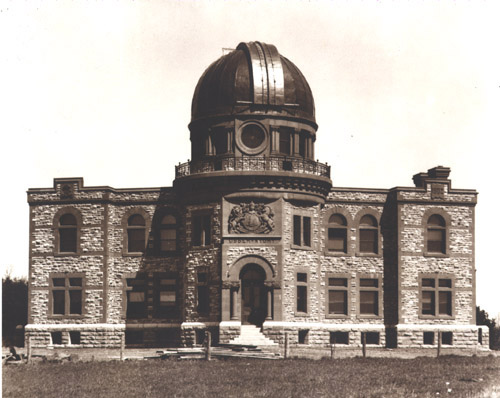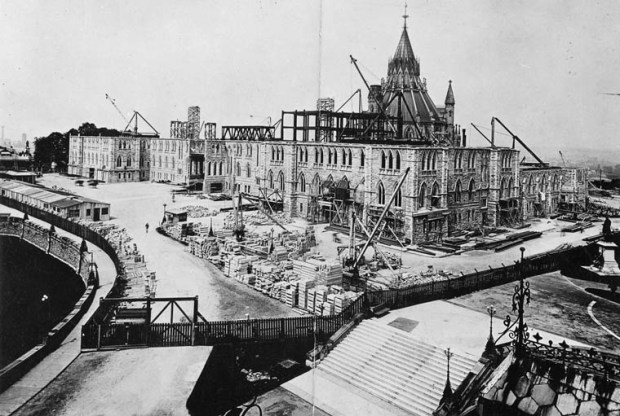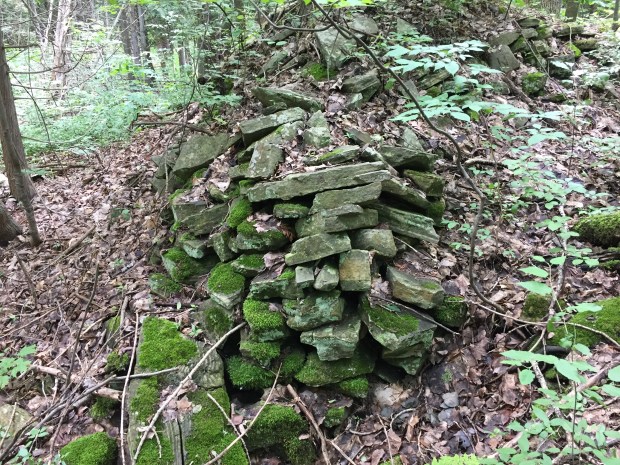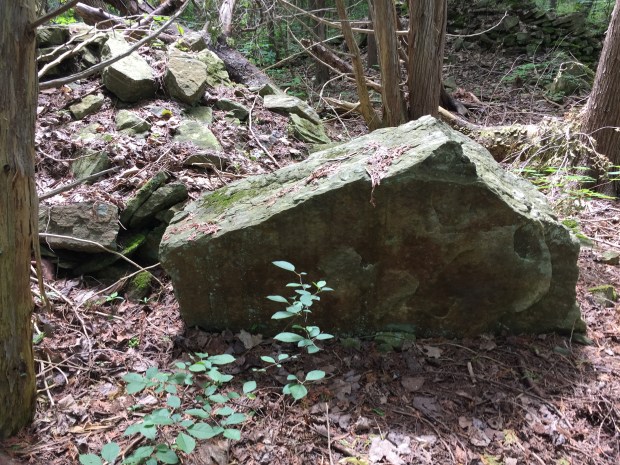For over a hundred years Canada’s parliament buildings have weathered the sands of time, pollution, salt and seismic activity, standing firm as the seat of this country’s government. Destroyed by fire in 1916, the original 1859 parliament buildings were rebuilt in 1916 using Canada’s finest building stones. But where did these stones actually come from? Hidden from view off the 417, with thousands of people unknowingly passing it each day, there lies a lost quarry, overgrown and forgotten, where Canada’s parliament buildings were born.

Canada’s Parliament Buildings were made from stone quarried west of Ottawa, near Bells Corners. (photo: Wikipedia)
LOCATING THE STONES OF PARLIAMENT
When the original 1859 parliament buildings were destroyed by fire in 1916, work began almost immediately on re-building them using what was considered to be Canada’s finest building stones. This stone was called Nepean Sandstone, and came from, as the name suggests, the Township of Nepean here in Ottawa. Nepean Sandstone is a mid-to-late Cambrian age rock found to the west of Ottawa near Bells Corners. Many of us drive over it on that ridge between Moodie Drive and Kanata, its outcroppings visible along the side of the 417. It is a well-cemented sandstone of nearly pure quartz, and was used to not only build the 1916 parliament buildings in Ottawa, but also the Museum of Nature, the Royal Canadian Mint and the Dominion Observatory. Stone from this quarry also provided the blocks needed to build Langevin Building (recently re-named the Office of the Prime Minister and the Privy Council) and the old Nepean Town Hall in Westboro.

The quarried Nepean sandstone was also used to build a number of Ottawa’s prominent buildings, like the Dominion Observatory.
From GeoScience Canada Volume 28, Number 1, 2001, it is quoted that the owner of the quarry received a shocking contract in 1916, and the demands for his special stone were high and the task of getting the stone to downtown Ottawa was gruelling:
“Our first order came from Peter Lyall Construction Company for 1,000 tons of sandstone all for the Parliament Buildings. When we got the parliament job there were several hundred men on the job and they just gobbled up the stone. We couldn’t get the stone out fast enough …Stone was hauled up to the building site by teams of horses, struggling along poor roads with six- ton loads. Each team could make but one trip a day.”

Canada’s parliament buildings under construction after being destroyed in 1916. Note the piles of stone that came from the forest quarry near Bells Corners. (photo: Library and Archives Canada)
In order to fulfill his duties of providing the parliamentary stone, the quarry owner brought in extra quarrymen and stone cutters from Scotland. The stonemasons carved out of the rocks near Bells Corners all the stone for the Centre Block and the Peace Tower. The quarry continued operation under various owners until 1962, when it was expropriated by the NCC where it remains forgotten and overgrown to this day.
But where exactly did this special stone come from? Nepean Sandstone means it came from Nepean, but where exactly? Finding a government document from 1964 called “ONTARIO DEPARTMENT OF MINES BUILDING STONES OF ONTARIO PART IV: SANDSTONE” there is listed on page 17 a mention that Campbell Quarries is where Canada’s parliamentary stone came from. Concession and lot numbers were given, which I matched up to an old map of the area, that marked “WHITE SANDSTONE QUARRY” on the map. This is the quarry where the stone came from, but where is it located today?

This old map indicates a “White Sandstone Quarry” just north of Bells Corners. This is the quarry where our parliamentary stone came from.
After using the old map with the quarry marked on it, and overlaying it with a current Google Map, the rough area where the Parliamentary Stone Quarry was determined.

Overlaying the old map on a current Google Map, the quarry can be pinpointed and its current location determined.
Setting off into the forest, the hidden quarry of Canada’s Parliament Buildings lies just off an NCC bikepath, and mere metres away from the bustling 417 highway. With camera in hand, I took to the forest and soon uncovered the overgrown remains of what was once a busy quarry site that provided Canada with its important building blocks for our Parliament.

Walking through the dense forest, one quickly stumbles upon the overgrown remains of the over 100 year old quarry where the stone for Canada’s Parliament came from.

It is clearly visible where the stonemasons over a hundred years ago carved out the stone needed for construction of the Parliament Buildings.

Piles of unused cut stones litter the forest floor.

The Nepean Sandstone beds can be seen on the surface, from which the stonemasons extracted the parliamentary stone.

This stone looks like it was being worked on with straight edges before being abandoned.

Piles and piles of unused stones litter the forest floor in this old hidden quarry.

Single large stones are slowly consumed by the growing forest.





Part of the cliff where the stone was cut from.



Worked over large stone.

Quietly forgotten on NCC property, the quarry of Canada’s Parliamentary Buildings, and many other distinct buildings in the Nation’s Capital, goes largely unnoticed without a plaque or marker to indicate its significance.
Andrew King, June 2017
SOURCES
GeoScience Canada, Volume 28, Number 1, 2001, “Building Stones Of Canada’s Federal Parliament Buildings”, D.E. Lawrence.

Reblogged this on Larry Muffin At Home and commented:
Another interesting article about a piece of our Canadian history.
Fabulous history, as always. I thoroughly enjoy the work you do here on your blog and always look forward to your next offering. Always SO interesting! You do a great job in uncovering that which we should have learned in school but sadly did not. Keep up the good work Andrew! Thank you for doing this.
Thanks Paul, glad you enjoyed it. I agree, these types of things should be taught in school, but sadly kids never learn the real history in their own backyard. I appreciate your support!
Thank you Andrew. I now live in China and just happened to link to an article that brought me to yours. Fascinating! Having lived in Ottawa for years in the 70s as well as having worked in the Parliament Buildings, I had absolutely no idea of the origins of these magnificent stones. You have brought history to life.
Thanks for reading David!
Well done Canada Day project. Thanks for the many photos.
You have many adventures.
Very interesting story Andrew. Connecting the present with the past in the manner you do is highly entertaining and informative. I look forward to your next Ottawa Rewind and the opportunity to revisit our history. Don’t ever doubt that your hard work is appreciated.
Thanks Neal! So glad to have your support…and sometimes I wonder if anyone reads or cares about these cool things…I appreciate your comments.
I used to work at the CANMET Bells Corners Complex north of Timm Drive. Inside the complex is a quarry that was used by CanmetENERGY to store oil drums and retired research equipment. I wouldn’t be surprised if some of the parliament stones came from this quarry as well.
Interesting! It was a large area they seemed to harvest the rock from. Lots of Ottawa buildings used that stone so much was taken from the area I presume.
Awesome post! Hope you don’t mind me stealing some of your photos. https://bellscorners.wordpress.com/2017/07/02/canada-day-free-food/
Not at all! Thanks for asking but please spread the word as you see fit! Cheers!
I too enjoyed this; thank you. I am always interested in rocks and stones.
Very impressive! Thanks for sharing – I would love to know more about this area – I walk in the Quarry Trail across from Hazeldean – but I don’t think this quite the spot you are pointing to? Anyway, great photos too!
Quite interesting. Thank you for the research and posting.
This post is so timely for me. Recent I started working in bellscorners and at lunch walking on the nearby trails. I noticed the piles of stones that can be seen from the paths and had been wondering what they were from (many ideas crossed my mind..but not a quary). Thank you for this post and all the others. I love reading them. You truly do a great job of telling the historic stories.
Hello Andrew. I just found your very interesting article and site. I have a question that I’m hoping you can help with. I’m from Wallace Nova Scotia. We have always been told that the sandstone from the wallace quarry was used extensively in the construction of the Parliament buildings. Would you happen to know if this is the case ? perhaps the wallace Sandstone was used in conjunction with the stone from the Nepean quarry . Again, thank you for helping preserve history.
Thanks for the note Linda…I believe the first parliament used stone from a variety of places so perhaps it was some of this Wallace Stone. The original burnt down, so I think they re-built it using the Nepean sandstone.
Hello Andrew,
Thanks for this great post. I am working on a new exhibition and wish to reference this quarry. Your post led me to go on a hike out there yesterday; fascinating place. I wonder if you wouldn’t mind emailing me so that I could discuss with you?
Thanks very much,
John
Hi John, Thanks for the note and interest…please email me at TheTimeWinder@gmail.com
Nice information you have shared with us. Thanks for your article.
stone wholesalers
In 1989, I was trained as a tour guide at the Museum of History, on the Quebec end of the interprovincial bridge. We were given lots of research materials to study before the opening, which was a controversial one due to costs. The principal stone material used for that project was Tyndall stone, which we were told was also used in the Parliament Buildings. Is it possible the Tyndall stone is used inside the Parliament Hallways and the Nepean sandstone on the exterior blocks, or somewhere else?
The Nepean Sandstone was used for the exterior of the Parliament Buildings and many other buildings around Ottawa.
Great stuff here. Looking at the images I cant see how they separated the stones from the mass. There is not cut marks or chiseled marks got be seen. The original building used stones from another quarry and before the time of black powder to separate. How did they cut or separate the stones from the mass?
Not a stone mason, so not sure….